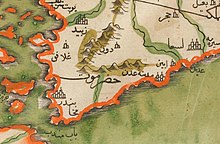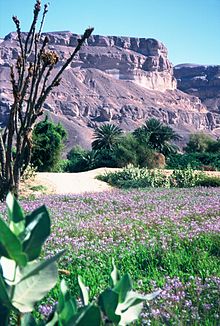Hadhramaut
Hadhramaut
حَضْرَمَوْتُ حَضْرَمُوتُ 𐩢𐩳𐩧𐩣𐩩 Ḥaḍramawt Ḥaḍramūt | |
|---|---|
UNESCO World Heritage Site | |
 Map of the Arabian Peninsula in 1914 | |
| Coordinates: 16°N 49°E / 16°N 49°E | |
| Countries or territories |
|
Hadhramaut
Etymology

The origin of the name of Ḥaḍramawt is not exactly known, and there are numerous competing hypotheses about its meaning. The most common folk etymology is that the region's name means "death has come," from Arabic: حَضَر, romanized: ḥaḍara, lit. 'he came' and Arabic: مَوْت, romanized: mawt, lit. 'death'.
Ḥaḍramawt has also been identified with
The origins of the name are unknown, with several scholarly proposals. Kamal Salibi proposed that the diphthong "aw" in the name is an incorrect vocalization.[3] He notes that "-ūt" is a frequent ending for place names in the Ḥaḍramawt, and given that "Ḥaḍramūt" is the colloquial pronunciation of the name and also its ancient pronunciation, the correct reading of the name should be "place of ḥḍrm." He proposes, then, that the name means "the green place," which is apt for its well-watered wadis whose lushness contrasts with the surrounding high desert plateau.
A now rejected etymology was proposed by Juris Zarins, rediscoverer of the city claimed to be the ancient incense trade route trade capital Ubar in Oman, who claimed that the name may come from the Greek word ὕδρευματα hydreumata, i.e. enclosed (and often fortified) watering stations in wadis.[4] Though it accurately describes the configuration of settlements in the pre-Islamic Wadi Ḥaḍramawt, this explanation for the name is anachronistic and phonetically inconsistent (for example, the name contains pharyngeal fricatives, which are neither found nor substituted for existing sounds in Greek).
Variations of the name are attested as early as the middle of the
Geography and geology

Narrowly, Hadhramaut refers to the historical
In a wider sense, Hadhramaut includes the territory of Mahra to the east all the way to the contemporary border with Oman.[8] This encompasses the current governorates of Hadramaut and Mahra in their entirety as well as parts of the Shabwah Governorate.
The Hadhramis live in densely built towns centered on traditional watering stations along the wadis. Hadhramis harvest crops of
Mountains
The Hadhramaut Mountains (
-
The city of Tarim
-
Hajjarin in Wadi Dawan
-
Shibam in Wadi Hadhramaut, with mountains in the background
History
Ancient

The Hadhrami are referred to as Chatramotitai in ancient Greek texts. Hadhramautic texts come later than Sabaean ones, and some Sabaean texts from Hadhramaut are known.[13] Greek, Latin, Sabaean and Hadhramautic texts preserve the names of a large number of kings of Hadhramaut, but there is as yet no definitive chronology of their reigns. Their capital was Shabwa in the northwest corner of the kingdom, along the Incense trade route. Eratosthenes called it a metropolis. It was an important cult centre as well. At first, the religion was South Arabian polytheism, distinguished by the worship of the Babylonian moon god Sin. By the sixth century, the monotheistic cult of Rahmanan was followed in the local temple.[13]
The political history of Hadhramaut is not easy to piece together. Numerous wars involving Hadhramaut are referenced in Sabaean texts. From their inscriptions, the Hadhrami are known to have fortified Libna (now
Early Islamic authors believed the nomadic Kinda tribe that founded a kingdom in central Arabia were originally from Hadhramaut, although distinct from the settled Hadhrami population.[13]
Modern
The Qu'aiti sultans ruled the vast majority of Hadramaut, under a loose British protectorate, the Aden Protectorate, from 1882 to 1967, when the Hadhramaut was annexed by South Yemen. The Qu'aiti dynasty was founded by Umar bin Awadh al-Qu'aiti, a Yafa'i tribesman whose wealth and influence as hereditary Jemadar of the Nizam of Hyderabad's armed forces enabled him to establish the Qu'aiti dynasty in the latter half of the 19th century, winning British recognition of his paramount status in the region in 1882. The British Government and the traditional and scholarly sultan Ali bin Salah signed a treaty in 1937, appointing the British government as "advisors" in Hadhramaut. The British exiled him to Aden in 1945, but the Protectorate lasted until 1967.[citation needed]
In 1967, the former British
The capital and largest city of Hadhramaut is the port
Exploration
Among Western explorers, British travellers
Economy
Historically, Hadhramaut was known for being a major producer of frankincense, which in the early 20th century was mainly exported to Mumbai in India.[22]: 84 The region has also produced senna and coconut. Currently, Hadhramout produces approximately 260,000 barrels of oil per day; one of the most productive fields is Al Maseelah in the strip (14), which was discovered in 1993. The Yemeni government is keen to develop its oil fields to increase oil production in order to increase national wealth in response to the requirements of economic and social development in the country. Oil contributes 30-40% of the nation's GDP, over 70% of total state revenues, and more than 90% of the value of the country's exports.[22]: 85
Hadhrami diaspora
Since the early 19th century, large-scale Hadhramaut
Earlier, several sultans in the Malay Archipelago such as the Malacca Sultanate,[27] Pontianak Sultanate or Sultanate of Siak Sri Indrapura were descents of Hadharem. In the 19th century, Hadhrami businessmen owned many of the maritime armada of barks, brigs, schooners and other ships in the Malay archipelago.[28] In modern times, several Indonesian ministers, including former Foreign Minister Ali Alatas and former Finance Minister Mar'ie Muhammad are of Hadhrami descent, as is the former Prime Minister of East Timor, Mari Alkatiri (2006).[29]
Hadhramis have also settled in large numbers along the East African coast,[30] and two former ministers in Kenya, Shariff Nasser and Najib Balala, are of Hadhrami descent. It has also been proved by genetic evidence[31] that the Lemba people of Southern Africa to the people of Hadramaut.[32]
Within the Hadramaut region there has been a historical Jewish population.[33][34][35]
See also
- Middle East
- The Federal Region
- The
Explanatory notes
- ^ Also Hadramaut, Hadramout or Hadramawt
References
- ^ Genesis 10:26
- ^ 1 Chronicles 1:20
- ^ Salibi, Kamal (1981). al-Qāḍī (ed.). "Ḥaḍramūt: A Name with a Story". Studia Arabica et Islamica: Festschrift for Iḥsān ʿAbbās on His Sixtieth Birthday: 393–397.
- ^ "Lost City of Arabia" (NOVA online interview with Dr. Juris Zarins, September 1996). PBS. September 1996.
- ^ "General word list". DASI: Digital Archive for the Study of pre-islamic arabian Inscriptions. Retrieved May 1, 2016.
- ^ Theophrastus: Historia Plantarum. 9,4.
- ^ ISBN 978-9-4017-3637-4.
- ISBN 1-85207-130-3,
...should be made along the coast to the west as far as the DHOFAR-HADHRAMAUT frontier...
- ^ Bilādī, ʿĀtiq ibn Ghayth (1982). بين مكة وحضرموت: رحلات ومشاهدات (in Arabic). دار مكة.
- ISBN 0-7614-7571-0.
- ISBN 0-7614-7571-0.
- ISBN 978-0-8577-3571-3.
- ^ OCLC 495469525.
- ^ "South Arabia". nabataea.net. Retrieved October 8, 2019.
- ^ al Asqalani, Ibn Hajar; Muhammad ibn Idrīs al-Shafii, Abū ʿAbdillāh; ibn Kathir, Ismail; ibn faisal al-Tamimi al-Darimi, Abu Hatim Muhammad. "Al-Isabah Fi Tamyiz Al-Sahabah by Ibn Hajr; al Istishaab by Shafii; al Bidayah wan Nihayah by Ibn Kathir; Kitab al Sahaba by Ibn Hibban". Islam story. Story of Islam. Retrieved February 11, 2020.
- ISBN 978-90-04-16121-4.
- ISBN 978-9-0040-0708-6.
- ^ Serjeant, Robert Bertram (1954). "Hud and Other Pre-islamic Prophets in Hadhramawt". Le Muséon. 67. Peeters Publishers: 129.
- ^ Al-Harawi, Ali ibn Abi Bakr. Kitab al-Isharat ila Ma rifat al-Ziyarat [Book of indications to make known the places of visitations].
- ^ Alexandroni, S. (October 2007), No Room at the Inn, New Statesman
- ^ See, The British-Yemeni Society, With Theodore and Mabel Bent in Southern Arabia (1893-1897)
- ^ a b Prothero, G.W. (1920). Arabia. London: H.M. Stationery Office. pp. 84–85.
- ISBN 978-0-520-93869-4
- ISBN 978-8-1715-4579-7
- ^ Manger, Leif (2007), Hadramis in Hyderabad: From Winners to Losers, vol. 35, Asian Journal of Social Science, pp. 405–433 (29)
- ^ Tan, Joanna (July 20, 2018). "Singapore's Arab community traces ancestral roots to Yemen's Hadhramaut Valley". Arab News. Retrieved December 11, 2023.
- ISBN 9-0041-0771-1.
- ISBN 978-90-474-2578-6.
- ^ Agence France-Presse
- ISBN 978-0-415-31763-4
- PMID 24300649.
- ^ Espar, David (February 22, 2000). "Tudor Parfitt's Remarkable Quest". NOVA. PBS. Retrieved February 4, 2015.
- ISBN 978-1-58465-032-4.
- ISBN 978-90-04-10110-4.
- ISBN 978-0-02-865936-7.
External links
- Architecture of Mud: documentary Film about the rapidly disappearing mud brick architecture in the Hadhramaut region
- Nova special on Ubar, illustrating a hydreuma
- Book review of a biography of Qu'aiti sultan Alin din Salah
- Hadhrami migration in the 19th and 20th centuries
- Ba`alawi.com Ba'alawi, the Definitive Resource for Islam and the Alawiyyen Ancestry






